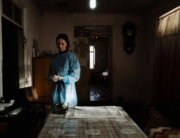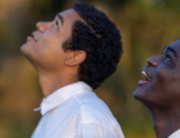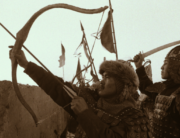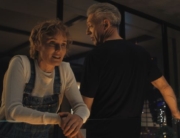The post-Impressionist painter Vincent van Gogh is the gift that keeps on giving. His paintings are the star attractions at the Museum of Modern Art and the Metropolitan Museum of Art, and just last year, his latter days were depicted in Loving Vincent through animation in the style of the artist’s thick brush strokes. Let’s also not forget Robert Altman’s Vincent & Theo (1990), starring Tim Roth and Paul Rhys, which centers on the van Gogh brothers’ close relationship.
Artist/filmmaker Julian Schnabel takes a more impressionistic (pardon the pun) or, to borrow another art history term, pointillistic approach to his new film, which closed this year’s New York Film Festival last week. Dabbing here and there, he and his co-screenwriters have imagined the last years of the life of the Dutch-born artist, played by van Gogh doppelganger Willem Dafoe. The result is a collage rather than an everything-but-the-kitchen-sink portrait.
Episodic as a narrative, it’s as though the filmmakers are riffing on what it would have been like for the painter to discover the light and dramatic landscape of the late-1880s South of France—it’s upon the suggestion of fellow artist Paul Gauguin (Oscar Isaac) that van Gogh leaves gray Paris for Provence. Not that that region needs further promotion, but Schnabel’s movie provides a road map for armchair and actual travelers alike; it was filmed in the actual towns and locations where van Gogh lived and roamed.
Luckily, the film does not subscribe to the biopic trope of easy summations or 21st-century diagnoses for a 19th-century life, only speculating as to the causes of his mental and physical ill health. In many ways, the filmmakers take a hands-off approach, focusing on van Gogh at work and his environment—the arid, mountainous terrain or the fields of lavender—often shot during the magic hour of dusk or dawn. In this way, we can see the deep blues and variations on the color green, all without Benoît Delhomme’s cinematography literally mirroring any of his paintings, unlike Loving Vincent, which becomes a guessing game of what work that movie is re-creating. According to Schnabel at the festival’s press conference, the actors improvised their dialogue and movements. In harmony with the freely roaming, handheld camera, the onscreen interactions feel spontaneous—to a point.
The languid dialogue, though, contains enough exposition to make viewers feel as though they are attending an art history class, with a lot of discussion about the meaning of art. Yet one of the more successful achievements of the movie is its depiction of van Gogh as an outlier, an innovator who offered a vision that was wholly unique. Even close confidant Gauguin complains that van Gogh over paints; the surface on a canvas looks like sculpture rather than a painting. Schnabel, in turn, forces viewers to literally watch paint dry as the artist layers brush stroke after brush stroke. Still, there is a lot of speechmaking that doesn’t flow freely, particularly in van Gogh’s walks with Gauguin, so their interactions come across as stagey. (“Nature is what we see here, in our minds,” according to Gauguin. “Painted reality is your own reality.”)
The film’s van Gogh certainly has self-awareness, knowing that he needs to work himself into a frenzied state in order to “forget” himself. As he explains to Gauguin, he sees more clearly and loses consciousness as he attempts to capture the essence of beauty in nature. He is also able to sum up the objective of his entire career—to reveal to others what he sees and to make them feel alive—and has the foresight to know that even if he’s unappreciated for now, he might be “a painter for people who aren’t born yet.”
Though the screenplay focuses briefly on certain interactions, it is more interested in a solitary van Gogh’s standing within the larger art world and how his back-to-nature calling infused his work, as opposed to, say, the central relationship in van Gogh’s life, which was with his art dealer brother Theo (Rupert Friend), a constant supporter of his younger brother’s endeavors.
For those fascinated by van Gogh, there’s likely to be little new here. More depth can be found, for example, in last year’s nonfiction YA title Vincent and Theo: The Van Gogh Brothers, by Deborah Heiligman, based largely on their life-long correspondence (At Eternity’s Gate’s screenplay was partially based upon the letters). Yet the main draw here is the re-creation of van Gogh’s world, featuring the scene-stealing scenery of Provence. Appropriate for a film made by a fellow painter, the radiant visuals provide the beating heart for what otherwise would have been a distant, thoroughly reverent series of sketches.







Leave A Comment